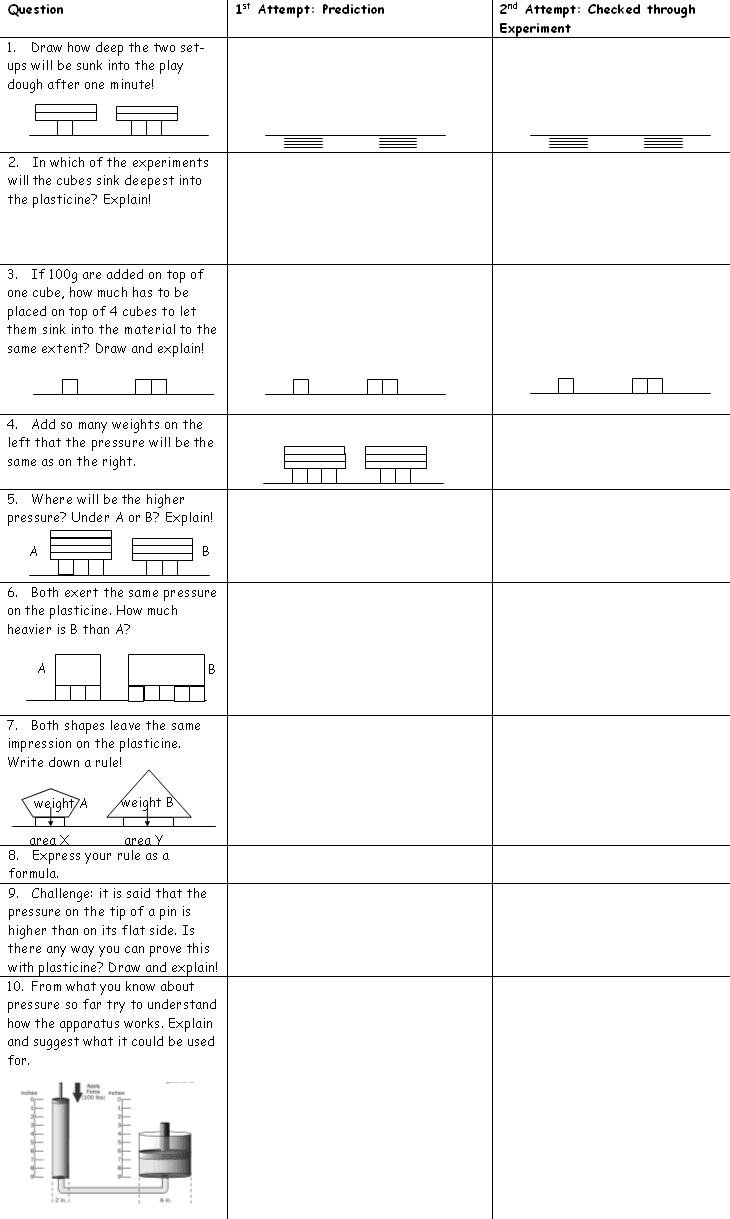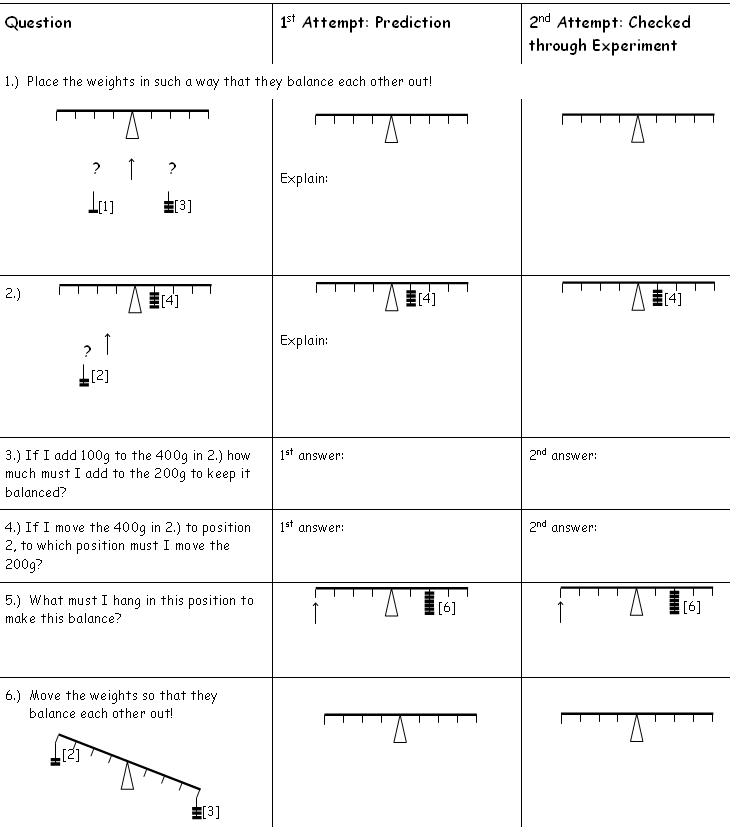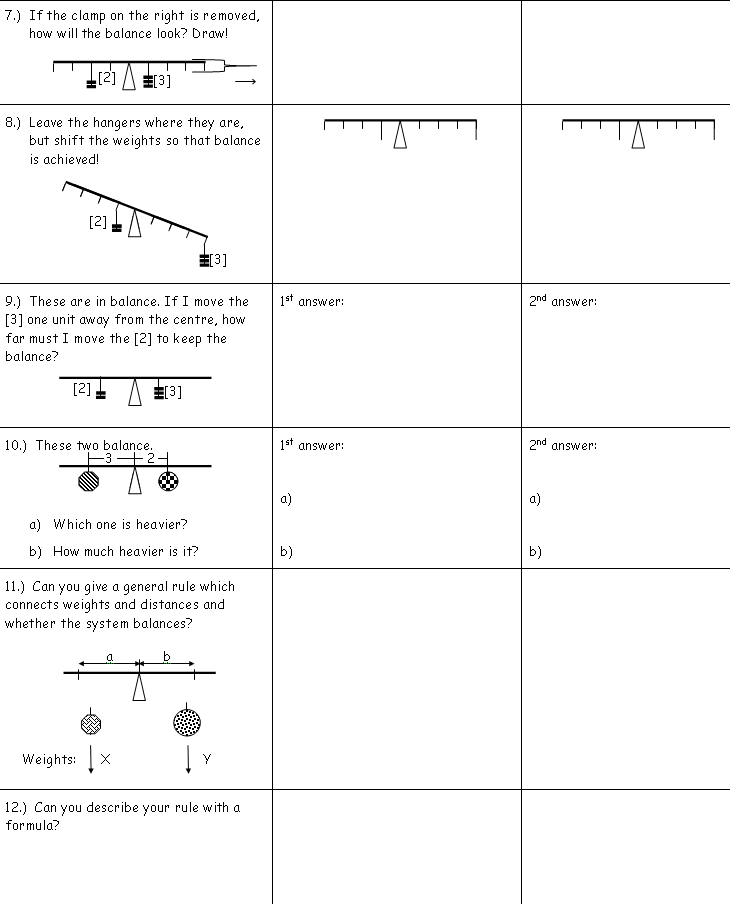SCIENCE
ENHANCEMENT PROGRAMME |
||||||||
 |
||||||||
| quick
link: menu | intro
| P | Q
| R | S | T
| U |
||||||||||||||||||||||||||||||||||||||||||||||||||
|
||||||||||||||||||||||||||||||||||||||||||||||||||
|
Developed
by Veit Martin Koch with Richard Worsey, Gareth Burley and Zulfikar
Sayeed. Sc4, Forces Deacon's School, Peterborough The Project Over a period of six weeks, a Y8 science top set was given a number of different tasks that incorporated higher level thinking skills according to Bloom's Taxonomy. The effect of such tasks on the pupils' motivation was analysed and evaluated. Three of these tasks are presented here. One of the ways of fostering gifted pupils is to engage them in challenging thinking, e.g. by letting them apply previous knowledge in a different context. Such tasks are presented here. Two of the tasks are an introduction to a new topic (moments and pressure respectively), and the other is an investigation into the practical application of the principle of moments. Instead of presenting the pupils with facts to memorise (rote learning), they had to develop their own ideas and find the laws. Daily life experience had to be applied to new tasks. Formulating their findings mathematically was a further step of abstraction. Higher level thinking skills are defined here as all levels above level 2 in Bloom's taxonomy (table 1). Tasks 1. A DART (Directed Activity Related to Text) activity on balances as an introduction to moments (appendix 1). Pupils had to solve the questions in two attempts – first from their own experience, then through experiments with a balance and masses. At the end of the task they were asked to express the laws they found both in words and mathematically. The DART activity in appendix 1 is a modified CASE (Cognitive Acceleration through Science Education) worksheet. • An investigation on examples of moments in the classroom (appendix 2). The moment is calculated by measuring the force and the distance. Errors have to be considered and a write-up is produced. Time limited to 50 minutes. • A DART activity on pressure similar to the first task. Pupils make predictions and test them through experiments (appendix 3). The relationship between force, area and pressure has to be expressed both in words and as a mathematical formula. The DART in appendix 3 is an improved version of the original in appendix 4. Outcomes Thinking Skills Overall, in all tasks, pupils did employ higher level thinking skills. In the DART activities the levels reached were particularly high. 1. The class average for correct answers on the CASE worksheet was 54%, and the best scoring pupil obtained 95%. It can be anticipated that the percentage of thinking at higher levels was higher than 54% suggests. (The probability of gaining a correct answer by guessing is far lower than the probability to get a wrong answer in spite of thinking at a high level.) 2. The levels of thinking (according to Bloom) required by the CASE worksheet questions were analysed, and pupils' answers were evaluated.
These results certainly exceed the thinking challenge of average teaching, which can over-emphasise knowledge and comprehension. 3. The investigation on applying moments demonstrates only a little higher level thinking. Pupils did not seem to be used to working on such an independent basis. A good example for this lack of independent thinking is the standard evaluation phrase "To make it a fairer test I would repeat the experiment more often." Appendix 4 shows two of the best examples. The highest level of thinking that pupils achieved was level 3 – application. 4. The DART on pressure was a good introduction into the topic since the pupils could develop their ideas and test them. The pupils seemed to grasp the concept more quickly compared to the similar exercise on moments. The class average for correct answers was 69%, and two pupils achieved 100%.
A disadvantage of this exercise is that pressure and depth of
impression are only proportional in the sense of an initial, rough
estimate. The depth of the impression is not easy to measure and
time is an additional factor. Therefore the results are not as
clear compared to the balance exercises. Two samples of pupils'
work are presented in appendix 4. Professional development benefits References:
Appendix 2: Pupil activity sheet – Moments investigation Moments in the Classroom (An Investigation) Aim: Calculate a moment in the classroom.
Appendix 3: Pupil activity sheet – Pressure Pressure  |
|

